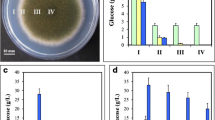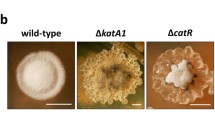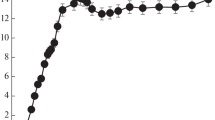Abstract
Physiological and morphological changes in carbon-limited autolyzing cultures ofAspergillus nidulans were described. The carbon starvation arrested conidiation while the formation of filamentous and “yeast-like” hyphal fragments with profoundly altered metabolism enabled the fungus to survive the nutritional stress. The morphological and physiological stress responses, which maintained the cellular integrity of surviving hyphal fragments at the expense of autolyzing cells, were highly concerted and regulated. Moreover, sublethal concentrations of the protein synthesis inhibitor cycloheximide or the mitochondrial uncoupler 2,4-dinitrophenol completely blocked the autolysis. In accordance with the propositions of the free-radical theory of ageing reactive oxygen species accumulated in the surviving fragments with a concomitant increase in the specific superoxide dismutase activity and a continuous decrease in cell viability. Glutathione was degraded extensively in carbon-starving cells due to the action of γ-glutamyltranspeptidase, which resulted in a glutathione-glutathione disulfide redox imbalance during autolysis.
Similar content being viewed by others
Abbreviations
- CAT:
-
catalase
- DCF:
-
2′,7′-dichlorofluorescein
- DCM:
-
dry cell mass
- G6PD:
-
glucose-6-phosphate dehydrogenase
- GPx:
-
glutathione peroxidase
- GR:
-
glutathione reductase
- GSH:
-
glutathione
- GSSG:
-
glutathione disulfide
- GST:
-
glutathione transferase
- γGT:
-
γ-glutamyltransferase
- ICD:
-
isocitrate dehydrogenase (NADP+)
- MTT:
-
3-(4,5-dimethylthiazol-2-yl)-2.5-diphenyl-2H-tetrazolium bromide
- ROS:
-
reactive oxygen species
- SOD:
-
superoxide dismutase
- CuZn-SOD:
-
Cu,Zn-superoxide dismutase
- Mn-SOD:
-
Mn-superoxide dismutase
References
Anderson M.E.: Determination of glutathione and glutathione disulfide in biological samples.Meth.Enzymol. 113, 548–555 (1985).
Ashok B.T., Ali R.: The aging paradox: free radical theory of aging.Exp.Gerontol. 34, 293–303 (1999).
Bahr J.T., Bonner W.D. Jr.: Cyanide-insensitive respiration. I. The steady states of skunk cabbage spadix and bean hypocotyl mitochondria.J.Biol.Chem. 248, 3441–3445 (1973).
Barratt R.W., Johnson G.B., Ogata W.N.: Wild-type and mutant stocks ofAspergillus nidulans.Genetics 52, 233–246 (1965).
Bruinenberg P.M., van Dijken J.P., Scheffers W.A.: An enzymic analysis of NADPH production and consumption inCandida utilis.J.Gen.Microbiol. 129, 965–971 (1983).
Cheng J., Park T.S., Chio L.C., Fischl A.S., Ye X.S.: Induction of apoptosis by sphingoid long-chain bases inAspergillus nidulans.Mol.Cell.Biol. 23, 163–177 (2003).
Chiu D.T.Y., Stults F.H., Tappel A.L.: Purification and properties of rat lung soluble glutathione peroxidase.Biochim.Biophys.Acta 445, 558–566 (1976).
Costa V., Moradas-Ferreira P.: Oxidative stress and signal transduction inSaccharomyces cerevisiae: insights into ageing, apoptosis and disease.Mol.Aspects Med. 22, 217–246 (2001).
Dunn-Coleman N., Prade R.G.: Toward a global filamentous fungus genome sequencing effort.Nature Biotechnol. 16, 5 (1998).
Emri T., Bartók G., Szentirmai A.: Regulation of specific activity of glucose-6-phosphate dehydrogenase and 6-phosphogluconate dehydrogenase inPenicillium chrysogenum.FEMS Microbiol.Lett. 117, 67–70 (1994).
Emri T., Pócsi I., Szentirmai A.: Glutathione metabolism and protection against oxidative stress caused by peroxides inPenicillium chrysogenum.Free Radical Biol.Med. 23, 809–814 (1997).
Emri T., Pócsi I., Szentirmai A.: Analysis of the oxidative stress response ofPenicillium chrysogenum to menadione.Free Radical Res. 30, 125–132 (1999a).
Emri T., Sámi L., Szentirmai A., Pócsi I.: Co-ordination of the nitrate and nitrite assimilation, the glutathione and free radical metabolisms, and the pentose-phosphate pathway inPenicillium chrysogenum.J.Basic Microbiol. 39, 109–115 (1999b).
Harman D.: Free radical involvement in aging.Drug Aging 3, 60–80 (1993).
Harvey L.M., McNeil B., Berry D.R., White S.: Autolysis in batch cultures ofPenicillium chrysogenum at varying agitation rates.Enzyme Microb.Technol. 22, 446–458 (1998).
Islam M.S., Nessa A.: Cell-biology of ageing, III. Malondialdehyde as an index of free radical reactions in the early senescent mutants ofNeurospora crassa and study of the effect of free radical scavengers on malondialdehyde contents.Cell Biol.Internat.Rep. 8, 373–377 (1984).
Jakubowski W., Biliński T., Bartosz G.: Oxidative stress during aging of stationary cultures of the yeastSaccharomyces cerevisiae.Free Radical Biol.Med. 28, 659–664 (2000).
Jüsten P., Paul G.C., Nienow A.W., Thomas C.R.: Dependence ofPenicillium chrysogenum growth, morphology, vacuolation, and productivity in fed-batch fermentations on impeller type and agitation intensity.Biotechnol.Bioeng. 59, 762–775 (1998).
Karaffa L., Vaczy K., Sandor E., Biro S., Szentirmai A., Pócsi I.: Cyanide-resistant alternative respiration is strictly correlated to intracellular peroxide levels inAcremonium chrysogenum.Free Radical Res. 34, 405–416 (2001).
Lahoz R., Reyes F., Perez-Leblic M.I.: Lytic enzymes in the autolysis of filamentous fungi.Mycopathologia 60, 45–49 (1976).
Leary N.O., Pembroke A., Duggan P.F.: Improving accuracy of glucose oxidase procedure for glucose determinations on discrete analyzers.Clin.Chem. 38, 298–302 (1992).
Lee D.G., Shin S.Y., Maeng C.Y., Jin Z.Z., Kim K.L., Hahm K.S.: Isolation and characterisation of a novel antifungal peptide fromAspergillus niger.Biochem.Biophys.Res.Commun. 263, 646–651 (1999).
Leiter E., Emri T., Gyemant G., Nagy I., Pocsi I., Winkelmann G., Pocsi I.: Penicillin V production byPenicillium chrysogenum in the presence of Fe(III) and in low-iron culture medium.Folia Microbiol. 46, 183–186 (2001).
Longo V.D., Gralla E.B., Valentine J.S.: Superoxide dismutase activity is essential for stationary phase survival inSaccharomyces cerevisiae.J.Biol.Chem. 271, 12275–12280 (1996).
Lorin S., Dufour E., Boulay J., Begel O., Marsy S., Sainsard-Chanet A.: Overexpression of the alternative oxidase restores senescence and fertility in a long-lived respiration-deficient mutant ofPodospora anserina.Mol.Microbiol. 42, 1259–1267 (2001).
McIntyre M., Berry D.R., McNeil B.: Response ofPenicillium chrysogenum to oxygen starvation in glucose- and nitrogen-limited chemostat cultures.Enzyme Microb.Technol. 25, 447–454 (1999).
Medvedev Z.A.: An attempt at a rational classification of theories of aging.Biol.Rev. 65, 375–398 (1990).
Mehdi K., Penninckx M.J.: An important role for glutathione and γ-glutamyl transpeptidase in the supply of growth requirements during nitrogen starvation of the yeastSaccharomyces cerevisiae.Microbiology 143, 1885–1889 (1997).
Mehdi K., Thierie J., Penninckx J.: γ-Glutamyl transpeptidase in the yeastSaccharomyces cerevisiae and its role in the vacuolar transport and metabolism of glutathione.Biochem.J. 359, 631–637 (2001).
Nagy M., Emri T., Fekete E., Sandor E., Springael J.Y., Penninckx M.J., Pocsi I.: Glutathione metabolism ofAcremonium chrysogenum in relation to cephalosporin C production: is γ-glutamyltranspeptidase in the center?Folia Microbiol. 48, 149–155 (2003).
Nestelbacher R., Laun P., Vondrakova D., Pichova A., Schüller C., Breitenbach M.: The influence of oxygen toxicity on yeast mother cell specific aging.Exp.Gerontol. 35, 63–70 (2000).
Oberley L.W., Spitz D.R.: Assay of superoxide dismutase activity in tumour tissue.Meth.Enzymol. 105, 457–464 (1984).
Paul G.C., Kent C.A., Thomas C.R.: Hyphal vacuolation and fragmentation inPenicillium chrysogenum.Biotechnol.Bioeng. 44, 655–660 (1994).
Pena-Muralla R., Ayoubi P., Graminha M., Martinez-Rossi N.M., Rossi A., Prade R.A.: Antifungal target selection inAspergillus nidulans. Using bioinformatics to make a difference, pp. 215–230 in K.J. Shaw (Ed.):Pathogen Genomics: Impact on Human Health. Humana Press, Totowa (USA) 2002.
Penninckx M.J.: A short review on the role of glutathione in the response of yeasts to nutritional, environmental, and oxidative stresses.Enzyme Microb.Technol. 26, 737–742 (2000).
Penninckx M.J., Elskens M.T.: Metabolism and functions of glutathione in micro-organisms.Adv.Microb.Physiol. 34, 239–301 (1993).
Perez-Leblic M.I., Reyes F., Martinez M.J., Lahoz R.: Cell wall degradation in the autolysis of filamentous fungi.Mycopathologia 80, 147–155 (1982).
Peterson G.L.: Determination of total protein.Meth.Enzymol. 91, 86–105 (1983).
Pinto M.C., Mata A.M., Lopez-Barea J.: Reversible inactivation ofSaccharomyces cerevisiae glutathione reductase under reducing conditions.Arch.Biochem.Biophys. 228, 1–12 (1984).
Pócsi I., Pusztahelyi T., Bogati M.S., Szentirmai A.: The formation ofN-acetyl-β-d-hexosaminidase is repressed by glucose inPenicillium chrysogenum.J.Basic Microbiol. 33, 259–267 (1993).
Pocsi I., Pusztahelyi T., Sámi L., Emri T.: Autolysis ofPenicillium chrysogenum — a holistic approach.Indian J.Biotechnol. 2, 293–301 (2003).
Pusztahelyi T., Pócsi I., Szentirmai A.: Aging ofPenicillium chrysogenum cultures under carbon starvation. II. Protease andN-acetyl-β-d-hexosaminidase production.Biotechnol.Appl.Biochem. 25, 87–93 (1997a).
Pusztahelyi T., Pócsi I., Kozma J., Szentirmai A.: Aging ofPenicillium chrysogenum cultures under carbon starvation. I. Morphological changes and secondary metabolite production.Biotechnol.Appl.Biochem. 25, 81–86 (1997b).
Reyes F., Villanueva P., Alfonso C.: Nucleases in the autolysis of filamentous fungi.FEMS.Microbiol.Lett. 57, 67–72 (1990).
Roggenkamp R., Sahm H., Wagner F.: Microbial assimilation of methanol induction and function of catalase inCandida boidinii.FEBS Lett. 41, 283–286 (1974).
Sámi L., Pusztahelyi T., Emri T., Varecza Z., Fekete A., Grallert Á., Karányi Z., Kiss L., Pócsi I.: Autolysis and ageing ofPenicillium chrysogenum cultures under carbon starvation: chitinase production and antifungal effect of allosamidin.J.Gen.Appl.Microbiol. 47, 201–211 (2001a).
Sámi L., Emri T., Pócsi I.: Autolysis and ageing ofPenicillium chrysogenum cultures under carbon starvation: glutathione metabolism and formation of reactive oxygen species.Mycol.Res. 105, 1246–1250 (2001b).
Sámi L., Karaffa L., Emri T., Pócsi I.: Autolysis and ageing ofPenicillium chrysogenum under carbon starvation: respiration and glucose oxidase production.Acta Microbiol.Immunol.Hung. 50, 67–76 (2003).
Sigler K., Chaloupka J., Brozmanová J., Stadler N., Hófer M.: Oxidative stress in microorganisms — I. Microbialvs. higher cells — damage and defenses in relation to cell aging and death.Folia.Microbiol. 44, 587–624 (1999).
Sipiczki M., Takeo K., Yamaguchi M., Yoshida S., Miklós I.: Environmentally controlled dimorphic cycle in a fission yeast.Microbiology 144, 1319–1330 (1998).
Skulachev V.P.: The programmed death phenomena, aging, and the Samurai law of biology.Exp.Geront. 36, 995–1024 (2001).
Tomarelli R.M., Charney J., Harding M.L.: The use of azoalbumin as a substrate in the colorimetric determination of peptic and tryptic activity.J.Lab.Clin.Med. 34, 428–433 (1949).
Trinci A.P.J., Righelato R.C.: Changes in constituents and ultrastructure of hyphal compartments during autolysis of glucose-starvedPenicillium chrysogenum.J.Gen.Microbiol. 60, 239–249 (1970).
Yip J.Y., Vanlerberghe G.C.: Mitochondrial alternative oxidase acts to dampen the generation of active oxygen species during a period of rapid respiration induced to support a high rate of putrient uptake.Physiol.Plant. 112, 327–333 (2001).
Warholm M., Guthenberg C., von Bahr C., Mannervik B.: Glutathione transferases from human liver.Meth.Enzymol. 113, 499–504 (1985).
Wawryn J., Krzepilko A., Myszka A., Bilinski T.: Deficiency in superoxide dismutases shortens life span of yeast cells.Acta Biochim.Polon. 46, 249–253 (1999).
White S., McIntyre M., Berry D.R., McNeil B.: The autolysis of industrial filamentous fungi.Crit.Rev.Biotechnol. 22, 1–14 (2002).
Wickens A.P.: Ageing and the free radical theory.Respir.Physiol. 128, 379–391 (2001).
Zhang Y., Herman B.: Ageing and apoptosis.Mech.Ageing Dev. 123, 245–260 (2002).
Author information
Authors and Affiliations
Corresponding author
Additional information
TheHungarian Ministry of Education awarded aSzéchenyi Scholarship for Professors to the last author. The third author was a recipient of aHungarian Scientific Research Fund postdoctoral fellowship, the first author was a grantee of theBolyai János Scholarship. This project was supported by theOffice for Higher Education Programs (grant no. 0092/2001) and by theHungarian Scientific Research Fund (OTKA: grant no. T0 34315 and T0 37 473).
Rights and permissions
About this article
Cite this article
Emri, T., Molnár, Z., Pusztahelyi, T. et al. Physiological and morphological changes in autolyzingAspergillus nidulans cultures. Folia Microbiol 49, 277–284 (2004). https://doi.org/10.1007/BF02931043
Received:
Revised:
Issue Date:
DOI: https://doi.org/10.1007/BF02931043




